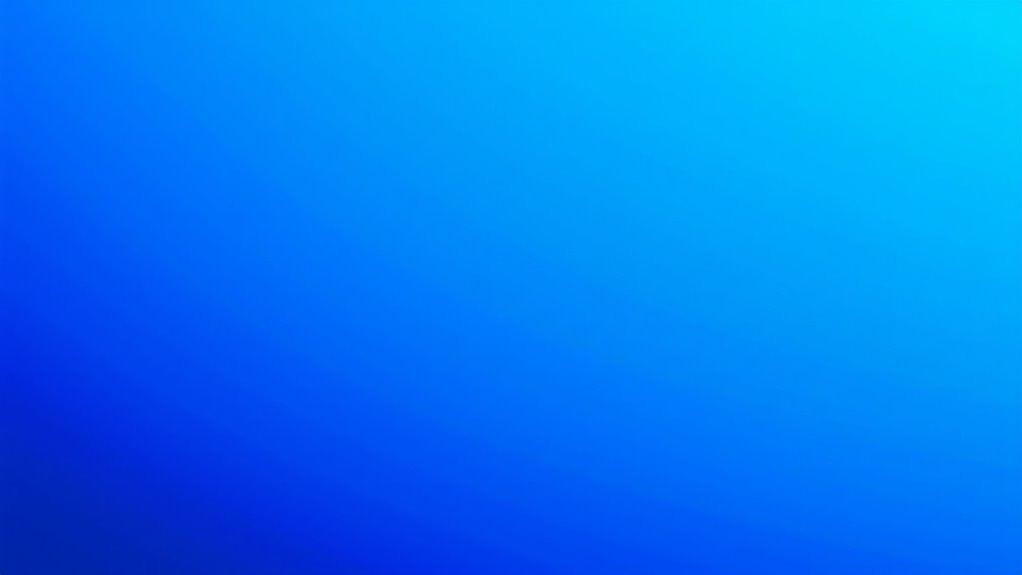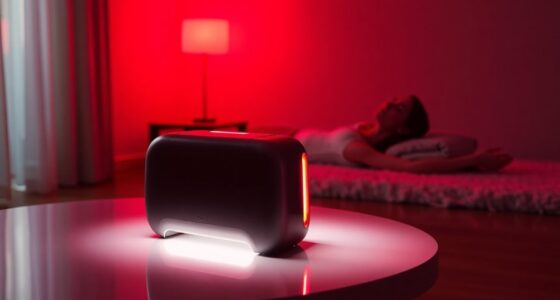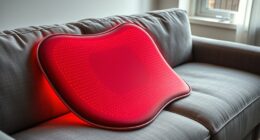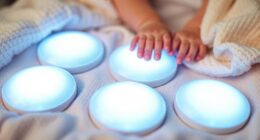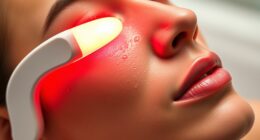Blue light wavelengths from 405 to 470 nanometers are part of the visible spectrum emitted by screens and digital devices. Exposure to this blue light can cause eye strain, dry eyes, and contribute to headaches. It also influences your sleep cycle by suppressing melatonin, making it harder to fall asleep at night. While this light can boost alertness during daytime, too much exposure may disrupt your rest. Keep going to discover how to balance its effects for better eye and sleep health.
Key Takeaways
- Blue light wavelengths from 405 to 470 nanometers are common in digital screens and emit a characteristic blue hue.
- These wavelengths penetrate deeply into the eye, potentially causing eye strain, dry eyes, and blurred vision.
- Exposure to 405–470 nm blue light in the evening can suppress melatonin, disrupting sleep patterns.
- Blue light in this range helps regulate alertness, mood, and cognitive functions during daytime.
- Managing exposure through filters or limiting screen time can balance benefits and reduce health risks.
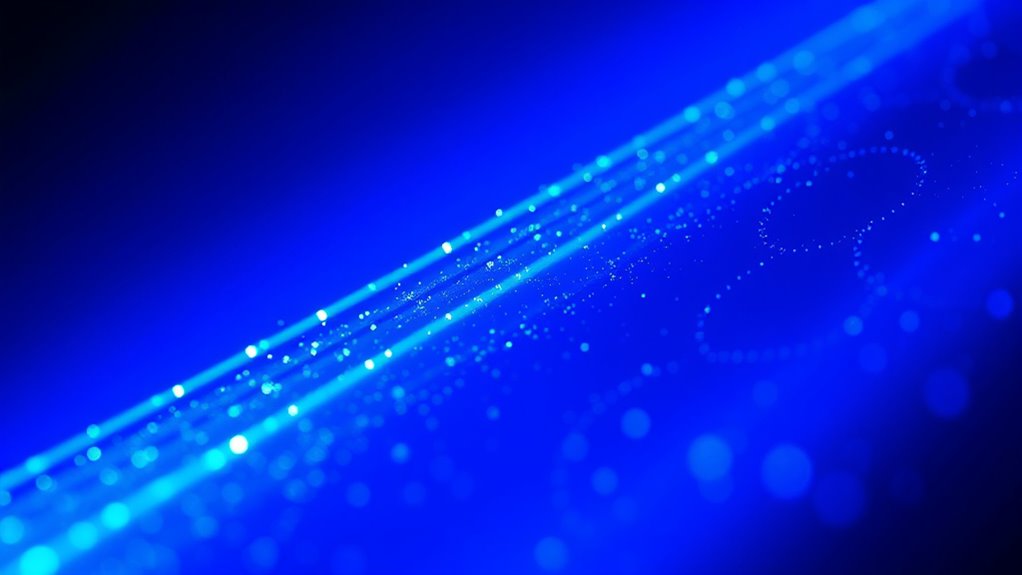
Blue light wavelengths are a specific segment of the visible light spectrum, ranging from approximately 380 to 500 nanometers. Within this range, the wavelengths from 405 to 470 nanometers are often highlighted because they are most prevalent in modern screens and digital devices. When you look at your phone, tablet, or computer, you’re mostly exposed to light within this range. These wavelengths are what give blue light its characteristic color, and they’re responsible for many of the effects you experience when using digital technology.
Blue light from 405 to 470 nanometers is most common in screens and affects sleep, eyes, and mood.
Your eyes are particularly sensitive to this part of the spectrum because the human retina contains cells called cones that detect blue light. These cells help you process color, but they also make your eyes more vulnerable to potential damage from prolonged exposure. Blue light with wavelengths around 405 to 470 nanometers penetrates deeper into your eye than longer wavelengths, reaching the retina and possibly contributing to eye strain or discomfort over time. When you stare at screens for extended periods, you may notice symptoms like dry eyes, headaches, or blurred vision, partly because of this blue light exposure.
Another important aspect of blue light in this range is its influence on your circadian rhythm, which is your body’s internal clock regulating sleep and wakefulness. Exposure to blue light between 405 and 470 nanometers, especially during the evening, can suppress the production of melatonin—the hormone responsible for inducing sleep. This can make it harder for you to fall asleep or disrupt your sleep cycle, leading to fatigue and decreased alertness during the day. That’s why many experts recommend limiting screen time before bed or using blue light filters and glasses designed to block these wavelengths.
You should also know that blue light in this spectrum plays a key role in regulating mood and alertness. During the daytime, exposure to blue light within 405 to 470 nanometers can help improve your focus, boost mood, and enhance cognitive function. The challenge is balancing this beneficial effect with the potential risks of overexposure, especially at night. Some devices now include settings or apps that reduce blue light emissions during evening hours, helping you protect your eyes and sleep better.
Understanding these wavelengths means being aware of how much blue light you’re exposed to daily. Being mindful of your screen time, especially in the evening, can help you avoid disruptions to your sleep and reduce eye strain. Additionally, research indicates that proper regulation of blue light exposure can mitigate potential health issues. By taking simple steps like adjusting device settings or wearing blue light glasses, you can enjoy the benefits of blue light while minimizing its drawbacks.
Frequently Asked Questions
How Does Blue Light Affect Sleep Quality?
Blue light can profoundly affect your sleep quality by suppressing melatonin production, making it harder to fall asleep. When you’re exposed to blue light from screens before bed, your circadian rhythm gets disrupted, leading to shorter sleep duration and poorer sleep quality. To improve your sleep, try limiting screen time an hour before bed or use blue light filters on your devices. This helps your body naturally prepare for rest.
Can Blue Light Exposure Damage Eye Health Long-Term?
Yes, prolonged blue light exposure can damage your eye health over time. It may contribute to digital eye strain, cause discomfort, and increase the risk of retinal damage. You should take steps to reduce exposure, like using blue light filters or glasses, especially during extended screen time. Regular eye check-ups are also essential to monitor and protect your eye health in the long run.
Are There Benefits to Blue Light Therapy?
Yes, blue light therapy offers benefits like improving mood, regulating sleep, and reducing certain skin conditions. When you use it properly, it can help counteract seasonal affective disorder and boost alertness during the day. Just make sure to follow your healthcare provider’s guidance and avoid overexposure, as excessive use may lead to eye strain or disrupt your sleep patterns. Overall, it’s a promising treatment when used responsibly.
How Do Different Screens Emit Blue Light?
Think of screens as modern-day lighthouses, emitting blue light in the 405–470 nm range. Your smartphones, tablets, and monitors produce this blue light through LEDs, LCDs, and OLEDs, which use different methods to generate images. They all emit blue light to enhance brightness and color accuracy, but the intensity varies. You can minimize exposure by adjusting brightness or using blue light filters, protecting your eyes from potential strain.
What Are the Best Methods to Reduce Blue Light Exposure?
You can reduce blue light exposure by using screen filters or glasses that block blue wavelengths, especially in the evening. Adjust your device settings to enable night mode or blue light reduction features. Limit screen time before bed, take regular breaks, and increase ambient lighting to lessen eye strain. These habits help protect your eyes and improve sleep quality by minimizing blue light impact.
Conclusion
So, next time you blame blue light for your sleepless nights, remember it’s just doing its job within that 405–470 nm range. Ironically, while we curse it for disrupting sleep, we willingly stare at screens for hours, fueling its glow. Blue light’s just trying to shine brightly—literally. Maybe it’s not the wavelength that’s the villain, but our obsession with screens that keeps us in the dark. Who knew science could be so cheeky?
